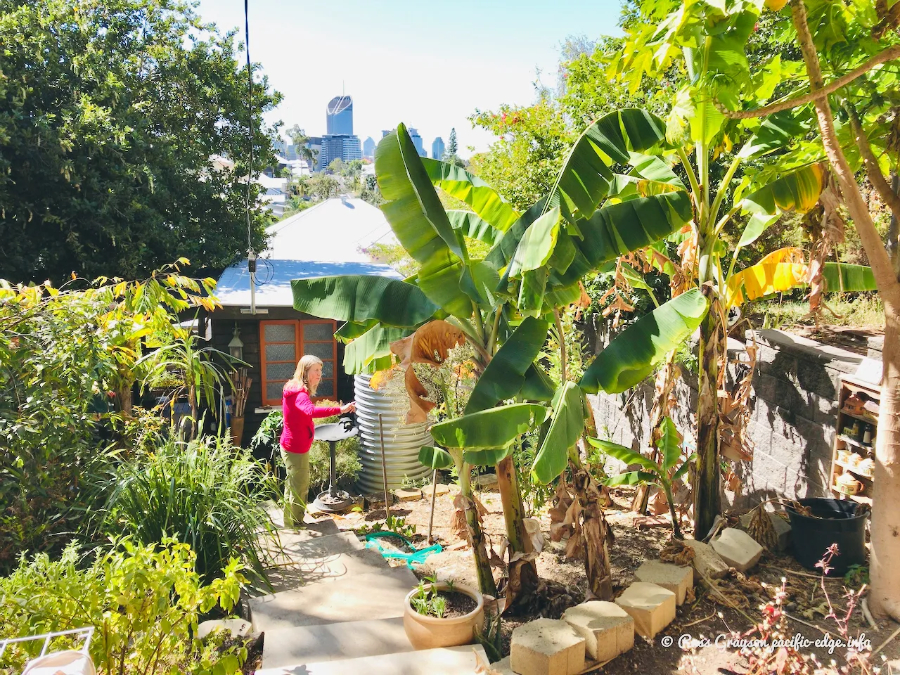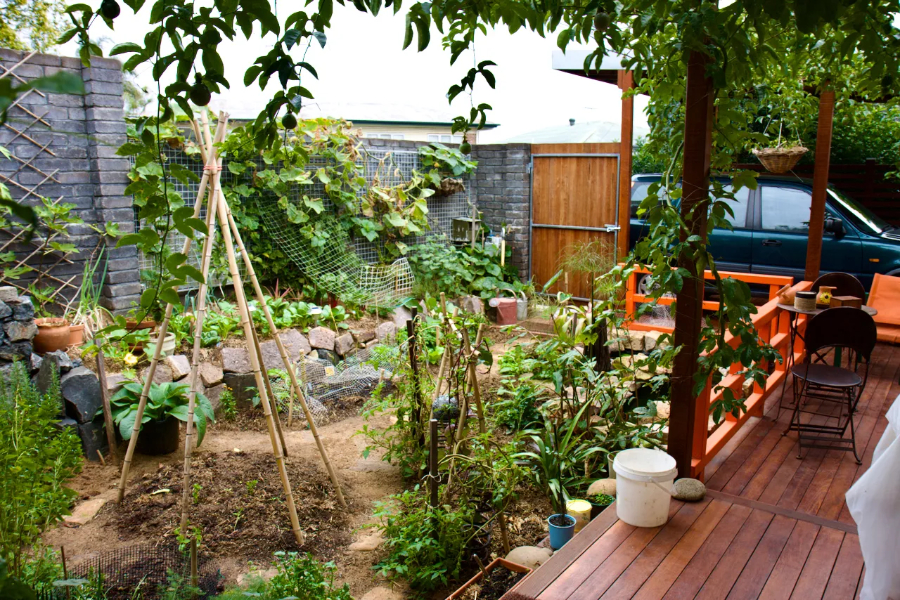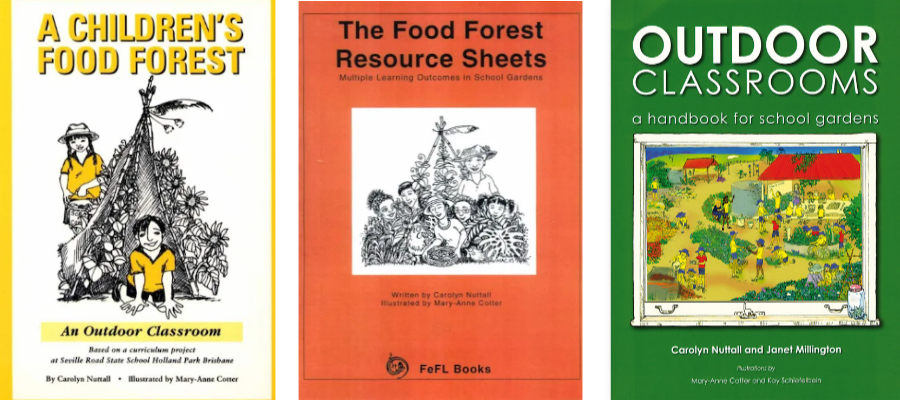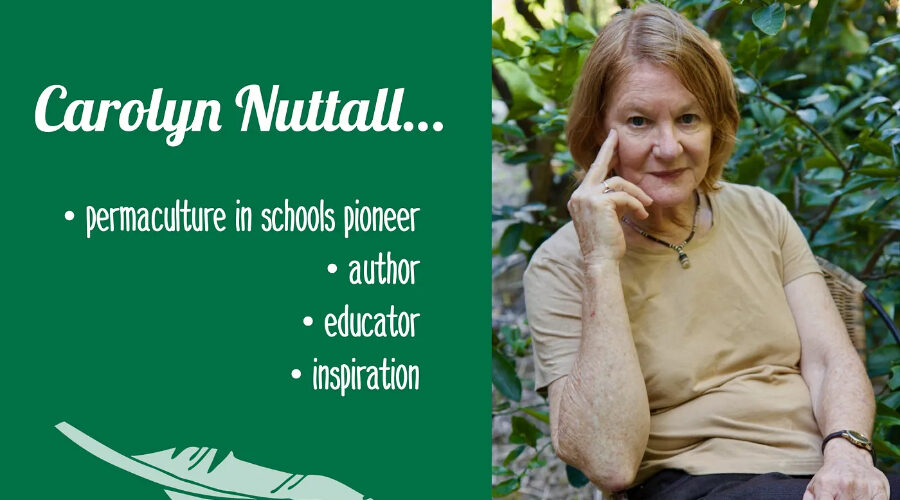The riches of long friendship — thank you Carolyn Nuttall
Story by Rosemary Morrow, 9 April 2023 (photos by Russ Grayson)
We go back 54 years.
It began in late 1969 when, as a young agriculture research graduate, I was posted to Ayr Cattle Research Station, south of Townsville. I arrived and knew no one.
In the first week, as I was unpacking, a car drew up and a vital redheaded, eye-catching young woman opened the door and stepped out saying
“You’re new in town, aren’t you? I am leaving for London in a few weeks with a friend Jan Smith on a boat, but I’d like to introduce you to some people in town. Can you water-ski?”
I couldn’t but I learned but never on one ski as Carolyn did.
Carolyn took me home to meet her family – the young ones, Julie (about 15 years old), Susan the youngest, and Ron the eldest who was standing as a Labor candidate. (The family was politically progressive and strong on social justice). I didn’t get to know the other two boys. One of them, Neville, had already left home. Lennie was busy with ‘boy stuff’.
As the eldest daughter Carolyn took naturally this traditional responsible role with complete panache, grace and style for all her brothers, sisters, in-laws and their children for the rest of her life. She taught me to be a better aunt.
The Nuttall siblings became, and are close – Christmases, birthdays, and family celebrations were often held at Carolyn’s home in Rosary Crescent in Brisbane. She bought the house and lived there without restlessness or big renovations, providing a base for siblings, nieces and nephews who came and went. Some lived with her when they came to Brisbane to study. Some came in need. Then their children stayed in the cabin or her flat under the house, as did my nephew Hugh, and my young great niece and nephew and me when they were in Brisbane. We were included in her extended family.
She was wonderful with Alice, her ageing mother, who came to live in Brisbane is the later years of her life. Carolyn found a friendly centre and home for her, not far from Rosary Crescent in West End. She took Alice and her friends to lunches. She visited her every day. She advised her on clothes to wear to family celebrations and admired her when she was dressed up. She lectured her when she dropped paper and materials on the floor while making cards and bookmarks. Alice adored Carolyn and Carolyn was devoted, interested and returned the love. I believe she adored her mother.
Carolyn opened her house to visiting permaculturists, and other friends of mine, all received a glass of wine and were invited to the verandah to look at the Brisbane skyscape fast becoming a city of glass towers.

When I met Carolyn, she was a primary school teacher and a good potter. Then she introduced her mother, Alice to pottery and Alice produced some beautiful works still to be found in Carolyn’s garden. Alice also made cards, and bookmarks and was a natural craftsperson.
She used to give her dad, Charlie, some money to put on the horses when she was home from College. Saturday afternoons he sat in his shed in the garden listening to his radio, barracking for his horse to win on Saturday afternoons. That was his indulgence.
Carolyn had won a scholarship to Teachers’ College in Brisbane and was a gifted teacher. When she later enrolled for a Masters in Education at Queensland University, and while she didn’t finish, her supervisor said that she was one of the few who had original ideas to offer education.
Later, in Brisbane, with some studies in Education, I became the beneficiary of long and idea-ridden creative discussions with Carolyn about how people learn. She’d sit in her chair, I’d lie on a carpet on the floor and we investigated this challenging topic for hours and hours.
I think she knew I had no one else to have these discussions with and I wanted permaculture teaching to be ‘care of people’, learner-centred and highly effective. She wrote the Introduction to my Teaching Permaculture Teachers manual. Today this introduction still describes faithfully how permaculture spreads.
No one has since filled this place for me with those deep, wide-ranging collegiate investigations into learning. Carolyn never hectored, insisted or tried to persuade. In discussion she would say “Have you read much of John Dewey, philosopher, and pragmatist, he writes with insight on this?” So I’d listen and then read Dewey.
From 1969 until this week, we would meet – by phone, email, text and sometimes by letter. She wrote letters for many years and I still have them somewhere. I remember reading some paragraphs to my mother who knew and loved Carolyn saying, “Carolyn has a wonderful ability to write”. I saw it was true and was a bit envious and then encouraged Carolyn to write. She didn’t believe me when I said she was endowed with lovely language and she would only write when pushed. She thought about and weighed words – always a sign of integrity. Her handwriting showed a flowing even hand which drew your eyes onward. Another gift which she lived lightly.
And then there was her photography. Carolyn worked in a bookshop In England, where she developed a ‘nose’ for valuable old books and prints. For a while her front room in Rosary Crescent became a prints and books shop. However she lacked confidence or the wish to continue it, but her interest is still there on the walls of her house. I want to see all those photographs one day – especially of the times we shared before we found permaculture.
I remember some wild adventures when we were living in Paris at the same time – Carolyn was ‘au pair’ for the Cultural Attache for the USA, a role which brought her the privilege of being immersed in European and American culture. Later we picked grapes in the Valley of the Loire, backbreaking work that was ameliorated by all the crates of red wine for breakfast, morning tea, lunch and dinner. Up at the Chateau, life was gracious but we lived on dirt floors and in ways that taught us how to pick our teeth with a very sharp pocket knife.
Back in Australia, Carolyn had a short bout of being a Real Estate agent. It was interesting because then it was mainly men’s business. She used to take people to visit houses and then tell them what was wrong with the house. She asked potential buyers about their finances and told them frankly if they couldn’t afford it. The men in the office said she’d got it wrong! But Carolyn sold more homes than they did.
Carolyn was very generous to me when I exhausted my resources. When I left Lesotho after four years there in Africa, I returned to Australia the ‘long’ way – catching the Trans-Siberian Express (it wasn’t) to Vladivostok and then boat to Japan. In Hong Kong I ran out of money and worked as a waitress in the (very British) Jockey Pub saved my fare home and arrived home. Very soon Carolyn arrived in her new green car. (She kept it for years and years). We had a few great days of ‘catch up’ and when I waved her off I went inside and found a $50 note on the table. It was a lot of money in those days and fed me for weeks.
When I fell upon permaculture in 1987, I phoned Carolyn. She was interested. She was teaching at Holland Park Primary School with a composite of Years 5 and 6. I recall those long cold dreary winters of short days hanging out in my kitchen at Blackheath. Carolyn and I were talking on the phone several times a week.
Carolyn asked what was possible:
“Could children learn permaculture?” Why not teach them?
“Could a school be transformed into zones?”
“Could she write a curriculum which satisfied the Department of Education yet was pure permaculture?”
“Could the children run the course and their own learning if they did research?”
I was a little taken aback. This was certainly going further than I’d considered or heard about. It was risky but Carolyn was a competent teacher with a gift so I enthusiastically endorsed every idea. She had a Principal who supported her. And the children did their own research. Soon the children were bringing old bricks, wire, seedlings etc. to school. The children were engaged. They designed the kitchen garden. Carolyn said they could spell cauliflower, broccoli, and carrot and measure geometrically paths, cubic compost bins, the height of fences and length of shadows.
The school submitted the project for the competition prize for Ecological projects in Queensland, and Holland Park came second in the state. Not long after this Stephanie Alexander contacted Carolyn and flew her to Melbourne to consult about gardens and cooking in schools. Carolyn appreciated the project but later said to me “the gardens could have been done by the kids for $50 start-up funds.”
At this time, she designed her tropical garden, beginning with mango trees which later became too big and then she redesigned it.

Her front garden was the first ‘tiny’ urban garden I had seen, and she espaliered a citrus. I used photos from this garden for years to show people how small spaces can be multi-purpose and highly productive. Later she built a ‘shed’ down the back for the overflow of visitors, using vintage materials which she loved. She haunted op shops and she had an eagle eye for bargains.

Carolyn went on to write her handbook for teachers. Then, with Janet Millington, she wrote The Outdoor Classroom which has had worldwide distribution; it was picked up throughout Europe and influenced the movement of Children in Permaculture (CIP). She and Janet were invited and financed to visit several countries in Europe and speak to those who wanted children to have a different and relevant education.

Carolyn did a most unusual PDC. She was ill with Tcell lymphoma and told me she had one chance in two of surviving it. She was having chemotherapy five days a week at the time. When she was well enough we did units in the morning, and in the afternoons went to the Brisbane Mater hospital. We’d take a whiteboard and Carolyn explained to the doctor and other patients having similar treatment to hers that they’d have to learn Soil – challenges, nutrition and repair. It is probably the most unusual class I have given. My nephew Michael with his faulty heart was in that class. Michael went on to work with National Parks in NSW in the rehabilitation of Maria Island on the Clarence River. It was a hugely successful class in terms of outcomes.
Carolyn eventually came out of the illness and remission. We went on to share a lovely holiday in Broken Hill with the Australian Bush Regenerators. Then at the last Australian Permaculture Conference in Brisbane, we were able to award her a Diploma in Permaculture Design and Education as an original contributor. She was gratified to receive this formal recognition.
However, what is it about long friendships? The phone calls, the shared interests of each other’s families, permaculture, writing, photography, gardens and plants.
Why do some friendships persevere through the decades? I think it is the qualities, the attributes of love and respect for each other.; the stories you share that your families don’t know. You phone each other when you are upset and when you are happy. The line is always open.
Carolyn lived all these – a good aunt and friend, generous without thought of reward, willing to listen and respond with interest, and she had the ability to pick up ideas and apply them with originality.
Above all, Carolyn had a great natural and moral integrity. She enjoyed her talents but never saw them other than gifts.
The last few years have been hard medically as she developed Parkinson’s Disease. She said it could have been caused by the years of chemo and radiotherapy, but then she told me at that time that those treatments would probably shorten her life. I never heard her complain; sometimes with humour, she discussed how she was going to a ‘sit down ballet class’ and we’d both enjoy her stories of this new culture. Some of it wasn’t so good.
What words describe the qualities that make such richness? I think it is appreciation, kindness, humour, generosity, creativity, and loyalty.
This glimpse of our long happy friendship highlights qualities that made it endure and that rest with me.
My world is diminished without this friend – the heavens are darker without Carolyn’s light and I will miss all we shared.
I am profoundly grateful she drove up to my new home in Ayr 54 years ago to say ‘hello’ to a new person in town.
Thank you Carolyn, with love and deep gratitude
Rowe April 9, 2023

